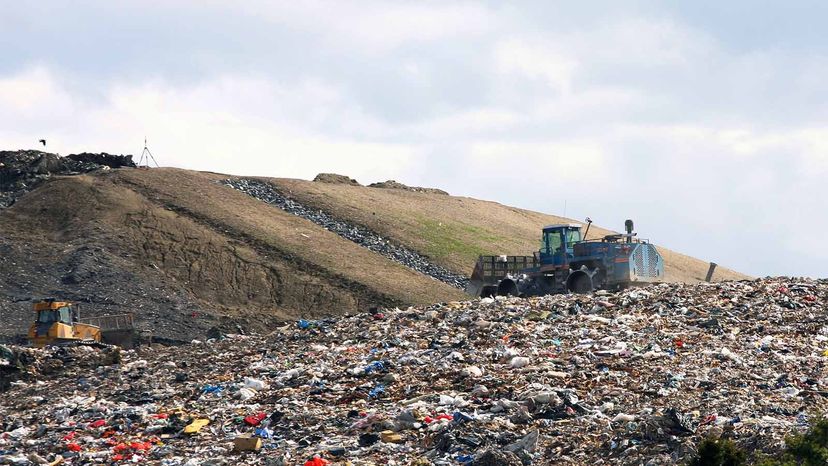You have just finished your meal at a fast food restaurant, and you throw your uneaten food, food wrappers, drink cups, utensils and napkins into the trash can. You don’t think about the trash again. On trash pickup day in your neighborhood, you drag your trashcans to the curb, and workers dump the contents into a big truck and haul it away. You don’t have to think about that trash again, either.

But maybe you have wondered, as you watch the trash truck pull away, just where that garbage ends up?
Americans generate trash at an astonishing rate of 4.9 pounds (2.2 kilograms) per person each day, which collectively amounts to 292.4 million tons (265.3 million metric tons) per year [source: EPA]. Americans produce roughly three times the global average for garbage, according to a 2019 report by research firm Verisk Maplecroft [source: Smith].
What happens to this trash? Some gets recycled or recovered, and some is burned, but the majority is buried in landfills. In this article, we will examine how landfills are built, what happens to the trash in landfills, what problems are associated with landfills and how these problems are solved.
How Much Trash Is Generated in the U.S.?
Of the 292.4 million tons (265.3 million metric tons) per year of trash that the U.S. generated in 2018, the most recent year for which data is available, 69 million tons (62.6 million metric tons) were recycled, and another 25 million tons (22.7 million metric tons) were composted. The recycled and composted trash amounted to 32.1 percent of the total. Another nearly 35 million tons (31.75 million metric tons) were combusted for energy recovery. But half of the nation’s trash — 146 million tons (132.4 million metric tons — ended up being buried in landfills [source: EPA].
How Is Trash Disposed?
The trash production in the United States has tripled since 1960. This trash is managed in various ways. About 32.1 percent of the trash is recycled or composted, and just about 50 percent is buried in landfills [source: EPA]. The amount of trash buried in landfills is about one-and-a-half times the amount put in landfills in 1960. The U.S. is the third biggest producer of trash after China and India, but the U.S. creates a disproportionate 12 percent of the world’s garbage, considering that it only has 4 percent of the world’s population [source: Smith].
What Is a Landfill?

What to do with trash has always been a problem in America. Up until the late 1800s, people often simply tossed their refuse into the gutter in cities such as New York, where it was common to see knee-high piles of food waste, broken furniture, horse manure and even dead animals on street corners [source: Oatman-Stanford].
Eventually, cities began to collect trash, but often garbage was hauled to dumps — open holes in the ground — where it often was burned, creating air pollution that was a hazard to human health. By the 1960s, though, it was obvious to local, state and federal government officials that something had to be done about trash.
In 1964, the U.S. Public Health Service (USPHS) issued a disturbing report, in which it predicted that solid waste generation would double in 20 years’ time, and that urban areas would run out of nearby land for garbage disposal. Additionally, the USPHS found that open-burning dumps were causing respiratory harm and posed disease threats, and polluted groundwater as well [source: Hickman].
Modern sanitary landfills — the first of which was created in California back in 1937 — became the solution to this problem. Instead of just dumping or burning trash, it was systematically buried, compacted with heavy equipment, and then covered. In 1976, Congress passed the Resource Conservation and Recovery Act, which imposed requirements on landfills to prevent them from polluting the environment [source: Zylberberg].
Today, there are about 2,600 landfills that handle municipal solid waste across the U.S. [source: EPA.]
These facilities, which are designed and operated to conform to federal regulations, primarily are for the purpose of handling household trash. In addition, municipal solid waste landfills also are allowed to take some other types of nonhazardous waste from businesses and industry.
They have a composite liner on top of 2 feet (0.61 meters) of compacted clay soil on the bottom and sides, as well as systems to capture leachate, the water that percolates down through the trash, before it can contaminate groundwater.
Additionally, landfills are equipped with groundwater testing wells to make sure that pollution isn’t escaping. Landfills also must use federally approved operating practices for handling the trash, which include compacting and covering it frequently with several inches of soil. That layer of soil helps reduce the odor and problems with insects and rodents, and also prevents trash from getting out of the landfill and turning into litter [source: EPA].
In the sections that follow, we’ll go into more detail about how landfills are designed and built, and how they work.
Getting Approval to Build a Landfill
Source: https://science.howstuffworks.com/environmental/green-science/landfill.htm
